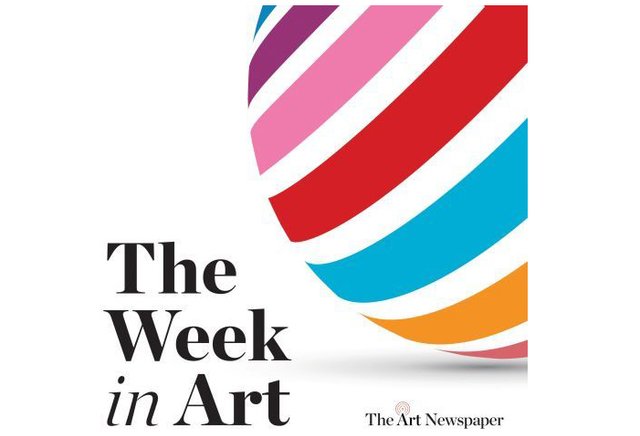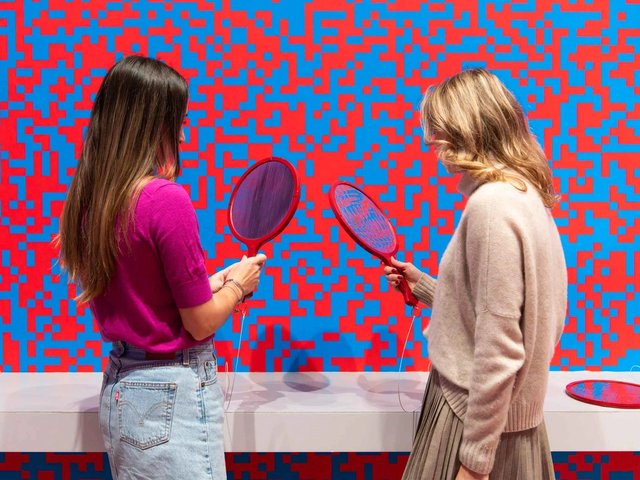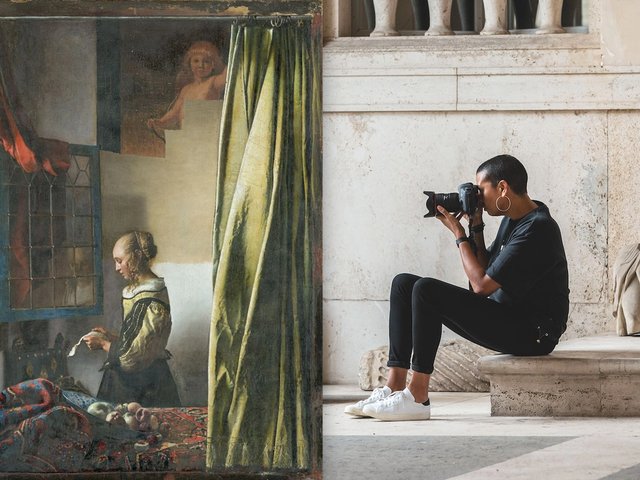Following on from opening her exhibition at the Whitney Museum of American Art, which continues until August, the US-born, Berlin-based artist Christine Sun Kim this week opened a show in London in collaboration with Thomas Mader.
The exhibition, 1880 THAT, uses a notorious historic conference in Milan in 1880, which effectively outlawed sign language in Deaf education, as a springboard to explore languages and stigma in Deaf and hearing cultures today. Ben Luke discusses the show with Kim and Mader—full transcript below.
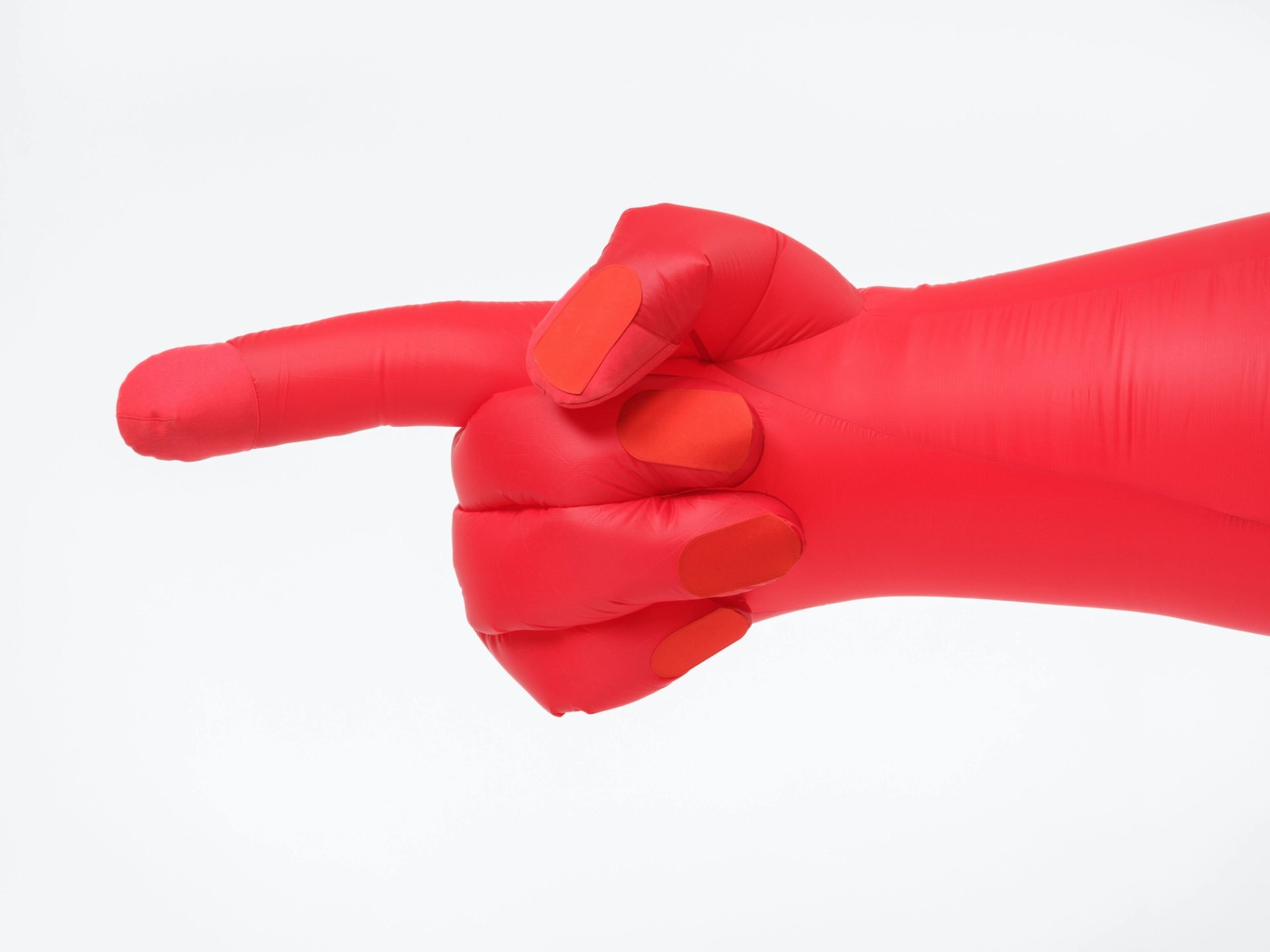
Christine Sun Kim and Thomas Mader, ATTENTION (2022, detail) Courtesy of the artists and Wellcome Collection. Photo: Steven Pocock
In Abu Dhabi, the latest museum devoted to the interactive art of the Japanese collective teamLab opens this week in the Saadiyat Cultural District. The Art Newspaper’s reporter in the Middle East, Melissa Gronlund, has visited the museum and tells us more about teamLab’s newest immersive experience.
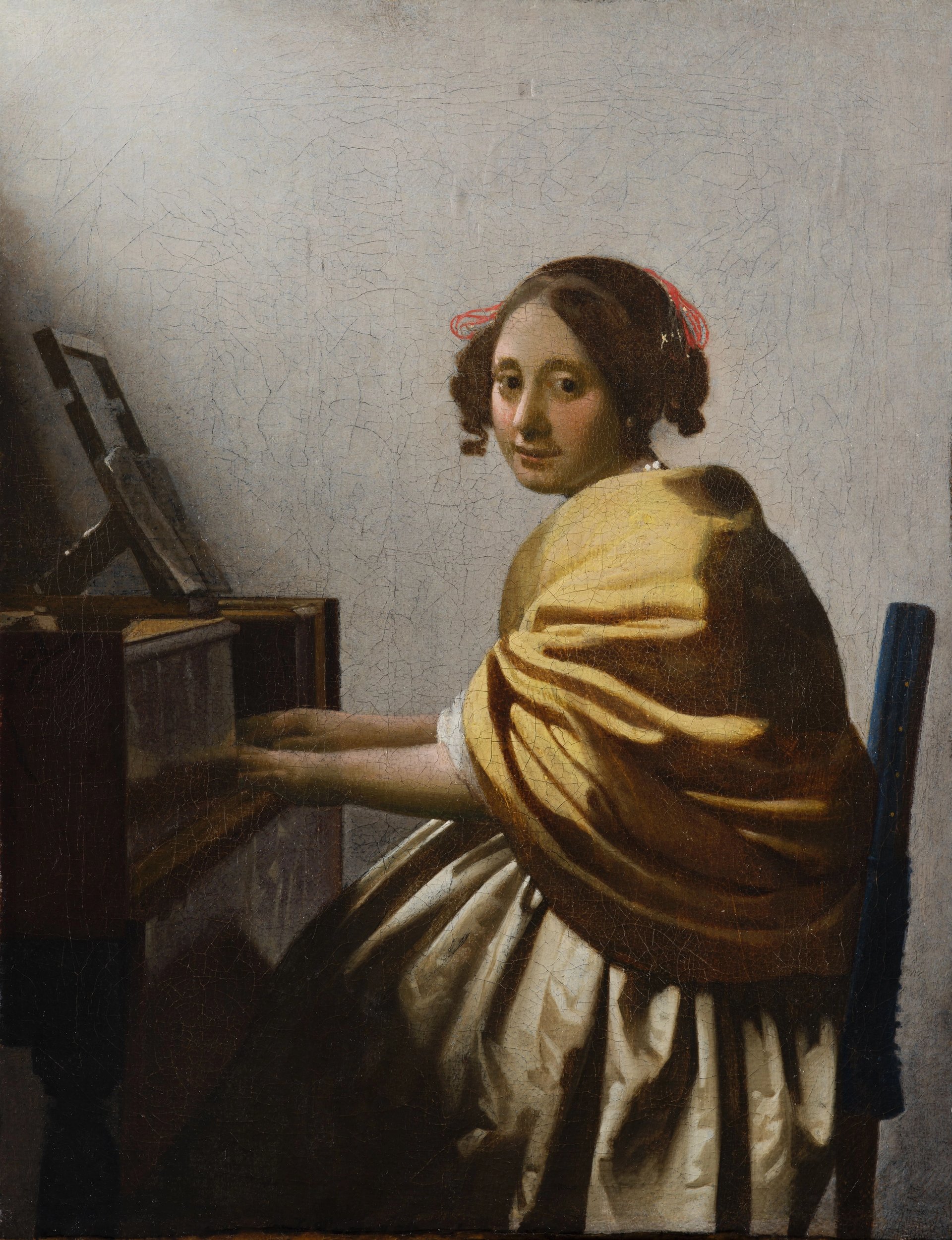
Johannes Vermeer, Young Woman seated at a Virginal Image: Courtesy of the Leiden Collection
And this episode’s Work of the Week is Young Woman seated at a Virginal (1670-75), a painting by Jan Vermeer that may be the very last picture he ever made. Our special correspondent, Martin Bailey, tells us how new conservation of the picture has revealed that 17th-century pollution may hold the key to dating the painting.
Transcript of Ben Luke’s conversation with Christine Sun Kim and Thomas Mader
At the Wellcome Collection in London this week, the Berlin-based artists Christine Sun Kim and Thomas Mader are showing a body of work exploring language as a place of belonging.
The forms of language at the heart of 1880 THAT, as the exhibition is called, are sign language, spoken language and text. The show features sculptures, drawings and video work themed around a notorious historic event, the 1880 Milan Conference, which had huge implications for Deaf education across the world. It involved Alexandra Graham Bell, or AGB, the man best known for patenting the first telephone.
I met Kim and Mader to discuss the show and Kim responded through American Sign Language interpreters.
The Art Newspaper: Christine, the exhibition centred around an event in 1880. Can you explain what that event was?
Christine Sun Kim: So it was the Second International Congress on Education of the Deaf (ICED). The first one took place in Paris before then, and then this particular one happened in 1880 in Milan. There were 164 delegates at this event, only one of whom was Deaf.
And at that time, Alexander Graham Bell, AGB, attended this congress, this event, and influenced the delegates there to vote to abolish sign language from Deaf education environments. That decision that they made was incredibly powerful and has had influence globally since then. So not a lot of people in this community, or in the general population, really know about this transpiring. This has had an incredible ripple effect. We're still seeing the effects of this event today.
Thomas, can you explain the use of the word “THAT”? Because it has a particular significance in terms of emphasis, right?
Thomas Mader: That's correct. So “THAT” was actually one of the first Deaf slang terms that Christine taught me, which is basically to indicate giving emphasis to a specific statement, to something that occurred. So if you're saying such and such had happened… “THAT”, that you add “THAT” in the end is like you’re adding a specific weight to that, it’s like “for sure” or “pay attention” or just, “I'm marking this as something that's specifically important.”
And Christine, the way that you first manifest the title 1880 That is through bricks. Why bricks? What's the significance there?
CSK: So the curator for this exhibit, Laurie Britton Newell, had gone to Milan and we asked her while she was there, can you check out the building where this event happened back in 1880? So she did, she went over there. I texted some friends to find out information about it and they had said that there was no plaque memorialising the event that took place, even though it has had such a huge impact. So we were under the impression that there weren't any plaques memorialising. We asked Laurie to go and check it out and there were multiple plaques memorialising many different events, but no mention of this 1880 ICED event. So she sent us lots of photos of the various plaques that were there. We created an artist's proposal for what a plaque for that event should be, should look like. And that's really what was the starting point of this whole exhibition. Tom, do you want to say more?
TM: Sure. We were thinking about the story of AGB as a notorious figure in the Deaf community is well known in North America, not so well known in Europe. We live in Germany, we talked to Deaf friends there. We talked to Deaf friends in the UK. They were mostly not aware of this part of his biography. And so we were thinking, what's AGB's beef with sign language? And one component to the story is that he was very much a man of his time. So he lived in a very rigid Victorian mindset, which is all proper, toned down. And so signing for him represented something that was too crude, too out there, too noisy, taking up too much space.
TAN: It was excessive.
TM: You could say that. And so we're thinking what element would help us connect how he's known in North America to what the experience is in England, in London particularly. And we're thinking [of the] Victorian age. And the brick is a really essential element of Victorian architecture. And at the time it was mostly family businesses that produced these small batch bricks, and they would all have their own individual stamps on it. So we're thinking, well, our collaboration is sort of a family business. Why don't we use that, make our own brand of bricks, and make it into a sort of plaque that is not too much in your face, as you have the blue plaques here that are very prevalent in London, but something that blends into the exhibition architecture, connects the different dots on the timeline. But also, pick up a brick and all of a sudden you have a means of self-defence.
TAN: I was going to say: Christine, it's a metaphor for resistance and protest as well, isn't it?
CSK: Absolutely, absolutely. If you are looking at the bricks, they're double-faced. So on one side, it says 1880, and it has a very Victorian-styled trim around that to represent the past, and then on the other side of the brick, you have the word “that”, with a much more contemporary trim, and the idea is that the past and the present go hand in hand, so that's what we were trying to include there. But what's happened in our past is still very much in our present. And Tom's right, resistance via this brick is done by the memory of what has happened and not forgetting.
TAN: And I wanted to explore the idea of metaphor in terms of the show more widely, Thomas, because it seems to me that the show is shot through with metaphors. There are all sorts of ways in which you're using imagery potently, with humour, and so on. Tell us more about the language of symbols, if you like, through the work.
TM: So language for us is just a really great plaything. And we would like for people to have as much a pleasant experience as this topic allows for. So, you know, it's often a problem that when it's an interview or a print interview, it's like, “Oh, something terrible happened in 1880.” But we do want to give people something to latch on to that is enjoyable and that is playful and that hopefully has people stick around just a little bit longer to then understand, “Oh, there's more layers to this.” And so playing with language and using metaphors is really a good tool for us to engage with an audience that's not necessarily in the same nerdy research bubble as we are. So when we're thinking about American Sign Language etymology, we can't very well expect many other people to be aware of what that is.
But through wordplay, through these metaphors that you had mentioned, hopefully there's something to latch on to.
TAN: Absolutely, and one of the ways in which that's done, Christine, is through these red arms that use ASL to point to really significant places. As in, one points literally to Milan, and the other gestures towards the Houses of Parliament. And this is a way in which you introduce ideas of, on the one hand, activism, but also these are arms that inflate and deflate. And that's the kind of symbol that I guess I was talking about before, in the sense that that deflation indicates an exhaustion with protest and activism, right?
CSK: I mean, that's a really interesting perspective. Yeah, you could definitely say that. There's a Deaf way of getting attention, which is very physical. And it involves tapping somebody on the shoulder, for example. And let's say somebody has been tapping your shoulder for a long time, over a long period of time. You might imagine that there would be an erosion of sorts, an indent in your shoulder to exemplify where it has been touched so frequently. And maybe even some pain associated with that. So if you envisage that and this idea of erosion, well, [it’s] the act of resistance, a continuous resistance. So when you're pointing to something, you're bringing attention to it. You're saying, look at this thing, look at this thing that I'm pointing at. This is the idea of the one hand, the right arm in the exhibition that is pointing at Milan. And then you can see a divot in the wall, the erosion in the wall from all this pointing. And then the other hand that's waving, is more about getting attention, or saying, “Hey, I'm talking to you”, right? So when it starts to wave, the up-and-down movement is quite subtle, and then it gets more and more prevalent. And you can see over time the frustration just building up, building up, and then it starts to dissipate. And then it just stays in that one spot as it's causing friction against the wall. So Tom and I just explained this piece a little bit more. We made the arms red, which is the colour of attention, of alerting, right? So that's why we went with the red for the arms.
TAN: Absolutely. And the work indeed is called ATTENTION. And it seems to me one of the other ways in which you're playing with language is through the titles, Thomas. The way that you use language in the titles is very direct. There's word play going on here, and that seems important too.
TM: That's right. Titles for us are basically just another material that [points] to the experience of what the piece can provide. And it very often happens that we are sort of approaching pieces the wrong way around, where we'd have a title first, and then we'll figure out what the piece could look like that would match that title, just because we like that sequence of words so much.
TAN: And would one of those works be Look Up My Nose, which is the work in which you use Alexander Graham Bell's nose and Melville Bell, his father's nose, [and Melville] is really significant in terms of that history, right?
TM: So in the process of working on that piece… of course, we came across so many expressions that have to do with the nose, for hearing people as well as for Deaf people. And then thinking about American Sign Language etymology again, North American Sign Language, when the first activists were trying to establish a more established system of education, they were looking at England specifically in order to copy a system for schools, etc. But the US had proclaimed independence from England about a hundred years before, and English people were still being salty about it. So when North American educators went to England to ask for guidance and feedback, basically what they heard was like, “Yeah, you don't want to be part of what this is. No, thank you.” So then they turned to France that also had an excellent system. And so sign language as a more institutionalised structure was introduced to North America largely through French missionaries and then merged with Native American sign language and regional dialects, home signs. And in French sign language, a lot of derogatory terms start from the nose. So by employing the shape of the nose, by giving this piece the specific title, we're flipping the saying “to look down one's nose” at somebody, which would have been Alexander Graham Bell's perspective on the Deaf community. We're flipping that on its head. But through etymology and word roots, we're also taking another subtle dig at who he was and what he was trying to do.
TAN: Absolutely. And the colour of the noses, Christine, is really important, isn't it? Because in both that sculpture that we just talked about and a drawing which is on the wall nearby it, you use a green colour which has a particular significance. Can you explain it?
CSK: The idea behind the colour has to do with, if we look at disability, Deafness, these are always situated in medicalised context. It's always pathological. So Deaf people are looked upon as people that need to be fixed, they need to be cured. We need to do something to them. And I just think it's really weird how people are just so obsessed, they're so fixated on giving Deaf people the same experience that they may have had from their own personal lives. Everything from music to the sound of birds tweeting. They're desperate for us to have the same life experiences, right? So they just want us to know what they know. And this really starts to drive all these things like ableism, the ideologies that they come with, eugenics. You know, AGB wrote about how to perfect the human race. He also wrote about something that was entitled Deaf marriage, which was him trying to convince Deaf people to not marry other Deaf people, right? So marry somebody who you think will have better genes than you have, so that you don't pass on Deaf genes, you don't have Deaf children. So [it was] the idea of eugenics erasing the Deaf life experience. We were thinking about that, we were trying to come up with a colour. Now, red we had already been delineated for the ATTENTION piece. So we played around with lots of different colour ideas. And then one day we were looking out the window over at UCH, University College Hospital, which was right across from the building that we were in at the time. We saw the green colouring, we thought, that's it, that's the colour that we want. So we are calling this colour Hospital Green. And after doing a bit of research on this colour, we see it's actually quite a standard colour used in hospitals: whether it's the surgeon's clothing or in other environments in hospitals, it seems that this is the colour of comfort. So for patients who are in recovery, this colour seems to be helpful. It also allows for less reflection so surgeons can get on with their work. It's also used a lot in mental health settings for the same reasons, but it seems to have had the opposite effect on Deaf people. So yeah, that's why we went with green.
TAN: I wanted to ask you about the use of pop-cultural references through the show. On the one hand, there's horror films. On the other, I know there's a reference to Monty Python in there. But the clearest and most obvious reference is the one to Sesame Street. Thomas, can you say why you want to work with that particular scene [with Lefty the Salesman], which is brilliant? You can watch it online: you can find these scenes that you have parodied or paid homage to in one of these pieces online. They're fantastic, but also it's very clearly also the moment where the two of you appear in the show. So tell us about that. Why Sesame Street? Why that particular Sesame Street sketch? And why important to bring yourselves into the work in that way?
TM: So we have two young daughters, so we do watch a bunch of children's programming. And especially in Sesame Street, there's always a focus on language education. And one character that really stuck with us is this character that's sort of a scammer, bootlegger called Lefty the Salesman. And thinking again about etymology and word roots, the Latin word for left is sinistra, which then morphed into contemporary English “sinister”, which of course has a whole different meaning. And left-handed people were regarded as something lesser than people who would use their right hand. And so there's already this element of hands and which side is the right side to move just in this character's name. And these stories basically came from a thinking of like, what if after 1880 really sign language was abolished completely and people using sign language had to go underground in order to use it. And the word “gesturing” always has a weird taste for Deaf people because it's always associated with, “Oh, [sign language] is not a real language, it's gesturing. This is something crude or imperfect or you can't really express everything with it.” But Gallaudet University in Washington, DC, which is a liberal arts college for Deaf education, has a branch specifically dedicated to gestures. And now, as has recently been pointed out to me by one of Christine's interpreters, it's actually a bedrock in many studies for language development, for what are the ancestors to language, what are the building blocks for what that is. And it is just another hint also that sign languages are really organic languages. And often, hearing audiences that are not very familiar with sign language would be asking why is there more than one sign language. But the answer is the same as why isn't there one language, because it was harder for people to travel, there's secluded communities, people make up what works for them. So that's why we have all these different languages.
And so the character very much lent itself to what we were trying to say with the show, and especially that character trying to sell Ernie things that are related to language. And we were really lucky to get an American Deaf actress, Linda Bove, who was the first Deaf reoccurring character on Sesame Street when Christine was a kid in the 1980s, who introduced sign language to millions of North American homes. So there are these elements of bringing back this character that was also at the time named Linda the librarian on the show. There's an element of archiving, of preserving a history. There's an element of communication having to happen in hiding. And there's an element of what are the building blocks of language and really identity and growth of self and identity that we might not be super aware of.
TAN: And I thought it was really marvellous that the Notebook scene [involving Lefty the Salesman on Sesame Street], for instance, is one that I had actually seen. And you pay quite a lot of close attention to that original scene from Sesame Street, don't you? So, for instance, I think he lives on 123 Sesame Street, but you change the exact address. But fundamentally, it's much the same scene as in that original clip. You're not just paying homage to the idea of that particular sequence in Sesame Street. You're actually very closely following it and bringing it into an art context.
CSK: Yeah, definitely. We wanted to maintain the original concept. We made some adjustments, like you said, the address. Tom can actually explain that bit.
TM: So I had recently heard a podcast about the history of Sesame Street, and they were explaining the roots how there wasn't really education on TV. And so the original makers of Sesame Street set out to create programming that was mostly catering to disenfranchised kids, so they could get education at home on TV. And so since we had Linda Bove present in the piece, doing the intros to the five different chapters of the piece, and we still wanted to diverge a little from Sesame Street and not use the “brand name” in the piece, we decided to rename the street Robinson Street, which is a reference to the first Black character on Sesame Street, and also the voice of the first muppet that is specifically referencing a Black character on Sesame Street.
TAN: That's wonderful. Lastly, I wanted to talk about the way that you present the interpretation in the show, because that seems to me to be really important. On the one hand, you have text panels, Christine, and then also you have a video with somebody using BSL. And what's great about that is that some of the detail is only in the video content. And I wonder how deliberately you did that. In other words, you have to look at sign language in this show in order to really get the full picture. Is that intentional?
CSK: So I'm American, and I've always tried to be really careful. Anytime I show work that has to do with American Sign Language or my own identity in spaces that are not America, are not representative of the American Deaf community, ASL has, in some countries, become pervasive in the way that spoken English has become. Right, so a lot of people around the world know English. There are a lot of Deaf people around the world who are learning ASL often as a first language, even though they're not in America. So when we put our work into these different contexts that do have their own sign languages, I'm really conscious of that, and I don't want to come across as language-colonising in any way. And sign languages do vary from country to country. So we wanted to work with a local guide, Damaris Cooke, who's actually a friend of mine. She's been very involved in presenting sports, like for football. I don't know what platform it is, but I've seen her work on a platform and presenting, and she's really good. So I knew I wanted her for this, as well. And I explained to her what we were doing, what we wanted to have done, all of the ideas around each of the pieces. And then, because she's Deaf herself, she was able to think from a Deaf perspective—“What would Deaf people want to know about the show? How should I present it for a Deaf audience?”—rather than initially creating it for a general audience and then interpreting that for a Deaf audience; we didn't want to do it that way. We wanted the show, the exhibit, to be Deaf-centred, Deaf-centric. So she did the descriptions in British Sign Language. It was then explained to Laurie in spoken English, which went into the text format and then that went into audio description. So it was quite a process, very arduous. But in the end, I feel like the Wellcome Collection, it's not an art museum, right? So their perception and the way that they're living, the idea of access is very different to what a traditional museum might do. And I appreciate this so much. I've never experienced this level of access being considered for a variety of disabilities in a way that's also educational and also artistic. We've never experienced that before. So our team came together, and we decided that we would do it this way. And we wanted to have a BSL description for each piece in our exhibition. And I think for those who come to see it that aren't familiar with the Deaf community, I think it's going to give them even greater exposure. And I really appreciate how Damaris' face is just really front and centre in these descriptions. I think in seeing real people's faces, it's a way of saying, “Look, I'm here and you have to look at me now. You have to notice me.”
TAN: Christine and Thomas, thank you so much.
CSK: Thank you so much.
TM: Thank you so much for your time. We appreciate it.
- 1880 THAT: Christine Sun Kim and Thomas Mader, Wellcome Collection, London, until 16 November; Christine Sun Kim: All Day All Night is at the Whitney Museum of American Art, New York, until 6 July
- teamLab: Phenomena, Abu Dhabi, opens 18 April
- From Rembrandt to Vermeer: Masterpieces from The Leiden Collection, H’ART Museum, Amsterdam, until 24 August.



